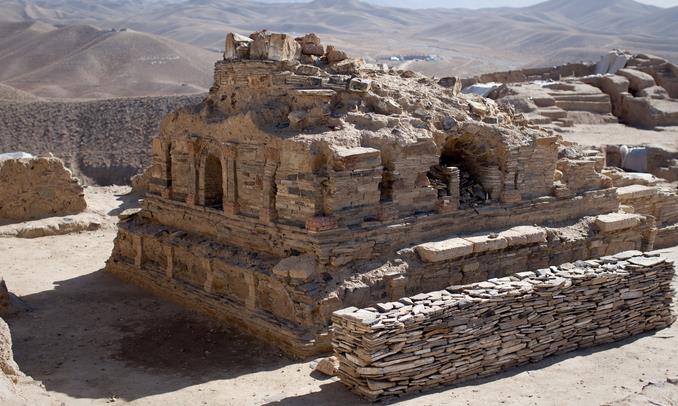Top 5 ‘Ethical Victories’ for Archaeologists in 2013
We have already published the worst archaeological destructions for 2013, which conveyed accounts of the decimation and destruction of a number of culturally rich and historically important sites. However, all is not lost. Here we showcase the better side of humanity – cases where indigenous sites and artefacts have been respected and ancient sites protected. These are the best ‘ethical victories’ for archaeologists in 2013, showing that morality does still exist in our society.
5. Archaeologists ‘do the right thing’ with human remains
 Archaeologists who uncovered the remains of individuals in 15 ancient burials at Polesworth Abbey in Warwickshire reburied the Saxon remains in a church service once samples had been taken for radiocarbon dating. Father Philip Wells, who conducted the service, said it was not clear yet if the remains were those of nuns from the original abbey. "These Christian ancestors will be honoured at the service and then those who have been involved with the dig will help to rebury them in a specially designated part of the present-day churchyard,” said Father Wells. The decision to rebury the individuals in a special service is a credit to the discipline of archaeology in which ethics and the desire for knowledge have come into numerous collisions, especially with regards to the custody and handling of excavated human remains.
Archaeologists who uncovered the remains of individuals in 15 ancient burials at Polesworth Abbey in Warwickshire reburied the Saxon remains in a church service once samples had been taken for radiocarbon dating. Father Philip Wells, who conducted the service, said it was not clear yet if the remains were those of nuns from the original abbey. "These Christian ancestors will be honoured at the service and then those who have been involved with the dig will help to rebury them in a specially designated part of the present-day churchyard,” said Father Wells. The decision to rebury the individuals in a special service is a credit to the discipline of archaeology in which ethics and the desire for knowledge have come into numerous collisions, especially with regards to the custody and handling of excavated human remains.
4. Energy company gets it right after discovery of ancient human bones
 The pipeline subsidiary of SaskEnergy in Canada, was undertaking a major pipeline project in Saskatchewan to supply natural gas service to a new mine site, when a number of ancient bones were discovered, estimated to be more than 1,000-years-old. Previous examples around the world have shown that Energy and Construction companies view such findings as little more than a considerable inconvenience, with some simply bulldozing straight through. For example, earlier this year it was reported that an ancient Aboriginal burial site was desecrated during the construction of an expressway in Australia. However, to their credit, SaskEnergy is redesigning the project in order to minimise any impact to the newly discovered cultural lands in the northwest of Regina, and is working with elders from the Nakota Nation to determine the most appropriate way to deal with the soil already disturbed. TransGas also says if First Nations leaders feel further archaeological work should be done, the company will ensure that occurs.
The pipeline subsidiary of SaskEnergy in Canada, was undertaking a major pipeline project in Saskatchewan to supply natural gas service to a new mine site, when a number of ancient bones were discovered, estimated to be more than 1,000-years-old. Previous examples around the world have shown that Energy and Construction companies view such findings as little more than a considerable inconvenience, with some simply bulldozing straight through. For example, earlier this year it was reported that an ancient Aboriginal burial site was desecrated during the construction of an expressway in Australia. However, to their credit, SaskEnergy is redesigning the project in order to minimise any impact to the newly discovered cultural lands in the northwest of Regina, and is working with elders from the Nakota Nation to determine the most appropriate way to deal with the soil already disturbed. TransGas also says if First Nations leaders feel further archaeological work should be done, the company will ensure that occurs.
3. American university returns 10,000 ancient tablets to Iraq
 In a move that pleased many historians and archaeologists, Cornell University forfeited their vast collection of cuneiform tablets, which detail daily life in ancient Mesopotamia, considered to be the cradle of civilisation. It is the largest return of antiquities by a U.S. university. The 10,000 inscribed clay blocks date from the 4th millennium BC and provide detailed administrative records of ancient life, including the procedures for temple rituals, the resettlement of refugees and the output of agricultural lands. The tablets were donated by the family of New York antiquities collector Jonathan Rosen to Cornell University in 2000. Many scholars objected to the arrangement, suspecting the tablets were looted in Iraq after the 1991 Gulf War. The Iraqi government requested the return of the tablets last year, and the U.S. attorney's office in New York organised the transfer. Other American universities have recently returned ancient artefacts after evidence emerged that the objects might have been looted. Last year, Princeton University returned about 170 objects and fragments to Italy and Ohio's Bowling Green State University said it was willing to return a dozen ancient mosaics to Turkey.
In a move that pleased many historians and archaeologists, Cornell University forfeited their vast collection of cuneiform tablets, which detail daily life in ancient Mesopotamia, considered to be the cradle of civilisation. It is the largest return of antiquities by a U.S. university. The 10,000 inscribed clay blocks date from the 4th millennium BC and provide detailed administrative records of ancient life, including the procedures for temple rituals, the resettlement of refugees and the output of agricultural lands. The tablets were donated by the family of New York antiquities collector Jonathan Rosen to Cornell University in 2000. Many scholars objected to the arrangement, suspecting the tablets were looted in Iraq after the 1991 Gulf War. The Iraqi government requested the return of the tablets last year, and the U.S. attorney's office in New York organised the transfer. Other American universities have recently returned ancient artefacts after evidence emerged that the objects might have been looted. Last year, Princeton University returned about 170 objects and fragments to Italy and Ohio's Bowling Green State University said it was willing to return a dozen ancient mosaics to Turkey.
2. A victory for archaeologists fighting to protect Mes Aynak
 Back in April we reported on a 5,000 year-old settlement in Afghanistan called Mes Aynak, facing destruction by a Chinese mining company who were drooling at the prospect of exploiting its rich copper reserves worth an estimated 100 billion dollars and set to become the world’s biggest copper mine. The contract between Afghanistan’s Ministry of Mines and Chinese state-owned China Metallurgical Group (MCC) was devastating for archaeologists who had been working tirelessly to recover the priceless remains of ancient Buddhist and Zoroastrian temples, ornately carved floors, delicate frescoes, manuscripts and other treasures. However, in a victory for archaeologists, the Ministry of Mines decided to renegotiate the multibillion-dollar contract for the site and mining works have been delayed for at least two years, giving archaeologists more time to recover the lost treasures of Mes Aynak. In a world where profits and greed take priority over the preservation of our ancient past, archaeologists can be reassured that all is not yet lost for Mes Aynak.
Back in April we reported on a 5,000 year-old settlement in Afghanistan called Mes Aynak, facing destruction by a Chinese mining company who were drooling at the prospect of exploiting its rich copper reserves worth an estimated 100 billion dollars and set to become the world’s biggest copper mine. The contract between Afghanistan’s Ministry of Mines and Chinese state-owned China Metallurgical Group (MCC) was devastating for archaeologists who had been working tirelessly to recover the priceless remains of ancient Buddhist and Zoroastrian temples, ornately carved floors, delicate frescoes, manuscripts and other treasures. However, in a victory for archaeologists, the Ministry of Mines decided to renegotiate the multibillion-dollar contract for the site and mining works have been delayed for at least two years, giving archaeologists more time to recover the lost treasures of Mes Aynak. In a world where profits and greed take priority over the preservation of our ancient past, archaeologists can be reassured that all is not yet lost for Mes Aynak.
1. US charity bought Hopi masks for $530k then returned them to tribe
 The Hopi tribal mask is revered as a sacred ritual artefact by the Native American Hopi tribe in Arizona. The masks are worn by dancers during religious ceremonies and are considered as living beings. When they are not used, they are stored behind muslin screens so they can ‘breathe’, and are ritually ‘fed’ corn pollen. They are considered so sacred, in fact, that a US charity just spent $530,000 to rescue 24 Hopi artefacts from an auction in Paris, in order to return them to their rightful owners.
The Hopi tribal mask is revered as a sacred ritual artefact by the Native American Hopi tribe in Arizona. The masks are worn by dancers during religious ceremonies and are considered as living beings. When they are not used, they are stored behind muslin screens so they can ‘breathe’, and are ritually ‘fed’ corn pollen. They are considered so sacred, in fact, that a US charity just spent $530,000 to rescue 24 Hopi artefacts from an auction in Paris, in order to return them to their rightful owners.
The auction was steeped in controversy ever since it was announced that it planned to sell a total of 27 objects considered sacred by Native Americans. The advocacy group, Survival International, tried to challenge the auction in court on behalf of the Hopis but was unsuccessful. The sale of sacred Indian artefacts was made illegal in the United States in 1990 but the law does not extend to sales overseas. So the Annenberg Foundation stepped in to save the artefacts from being bought by private buyers. In total they purchased 21 Hopi masks and three San Carlos Apached objects “for the sole purpose of returning them to their rightful owner.”
By John Black



















